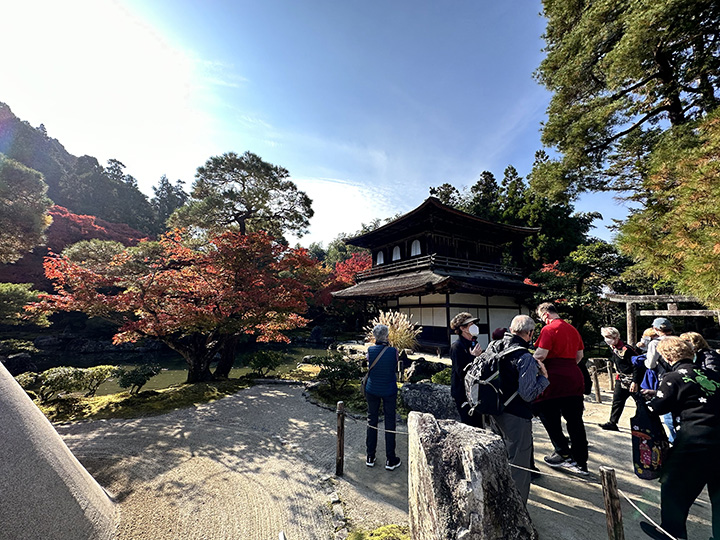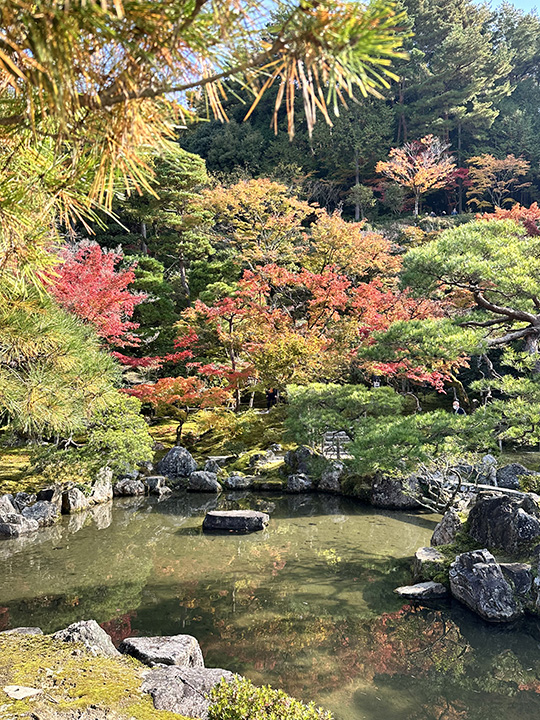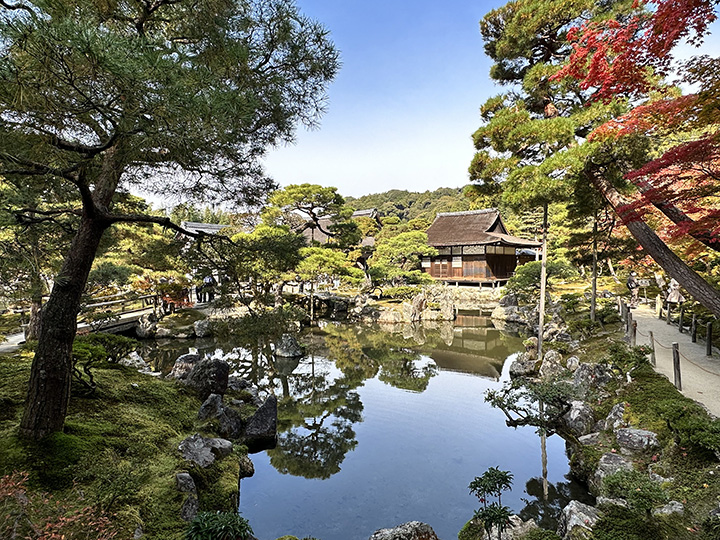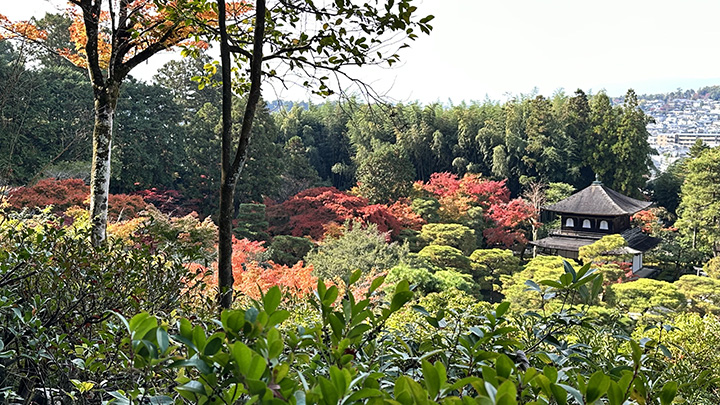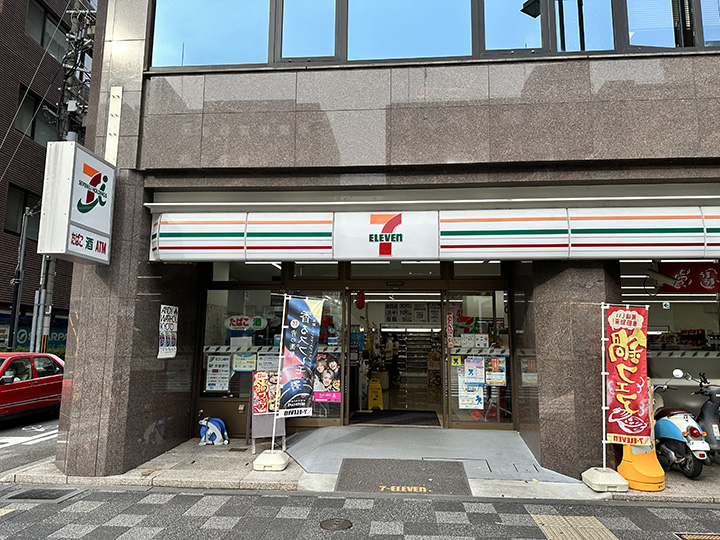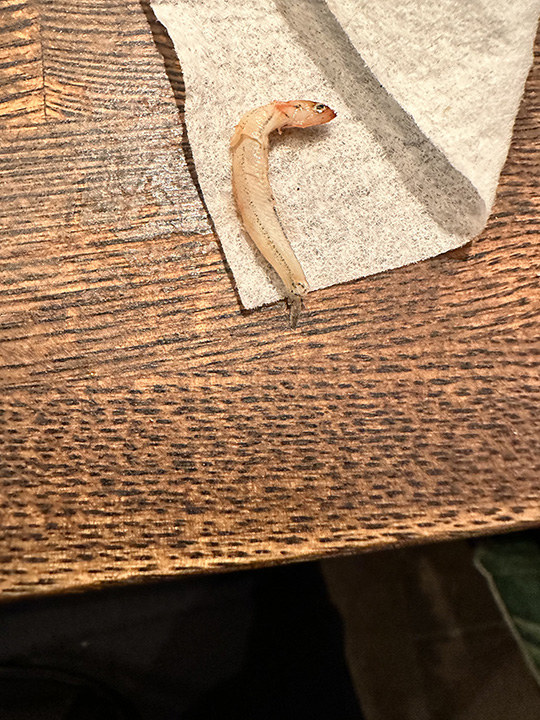|
Today was not as jam-packed with activities as other days have been. We visited a Shinto shrine, toured an arts and crafts museum, saw a silver pavilion, ate Japanese curry, and heard a briefing on how to repair pottery. After that, some of the Road Scholars took taxis to other sights, and others went shopping. Personally, I accomplished something I had been hoping to do for days. I rested.
Have you ever seen a breakfast condiment dispenser like this in the USA? I don’t remember seeing anything like it. Note that it contains in the separate plastic pouches both butter and jam. When you bend the whole thing in half, a couple of holes pop open and you can squeeze the butter and jam onto your toast. Pretty neat, right?
Indoors or out, everybody wears a mask. It is just the social thing to do. If you don’t wear one, you feel out of place.
We have arrived at the Heian Jingu (shrine). It has a relatively short history, dating back just over a hundred years to 1895. T
It boasts a magnificent torii gate.
The shrine was built on the occasion of the 1100th anniversary of the Japanese capital's foundation in Kyoto and is dedicated to the spirits of the first and last emperors who reigned from the city: Emperor Kammu (737-806) and Emperor Komei (1831-1867). Heian is the former name of Kyoto.
You can read about it here.
Let’s have a look inside.
Believe it or not, this is a commercial advertisement. Sake is an integral part of some Buddhist ceremonies and the sake manufacturers keep shrines and temples supplied for free, as long as they get to advertise at the entrances. So those little barrels feature logos of sake manufacturers. You scratch my back and I'll scratch yours.
Some VIP businessmen apparently had some business at the shrine this morning.
The actual shrine grounds themselves are very spacious with a wide open court at the center. The shrine's main buildings are a partial replica of the original Imperial Palace from the Heian Period, built on a somewhat smaller scale than the original.
Recent renovations have left the decorations looking shiny new.
That is some sort of citrus tree according to Kathleen.
And that is a different sort of tree altogether.
Worshipers have tied prayers to all the branches.
They wouldn’t let us take pictures inside. But I can tell you it was an elaborate Buddhist temple.
That's the entrance.
And this guy and his twin are guarding it.
You don’t really see people walking around in kimonos much. We theorized that this group is here for a special ceremony today.
Now let's go visit a museum just down the street.
The Kyoto Museum of Crafts and Design is only a couple of blocks away from the shrine.
We saw a local crafts of all sorts, including these lovely kimonos.
Just look at the detail in the design.
They wouldn’t let me ring the gong.
Or shake the pretty bells.
But I could admire the fabrics.
And the pretty fans.
There was a lady doll.
And a samurai doll costume.
And a small diorama with everyone dressed formally. These are just a few of the many pictures I took of various arts and crafts, many exquisite.
Sake logos!
A Butsudan is an altar for people who practice Buddhism. One can distinguish a Butsudan altar by its exterior that often resembles a simple cabinet, with two outward opening doors. It houses a Gohonzon or religious icon, typically a statue or painting of Buddha or Bodhisattva, or sometimes a calligraphic mandala scroll. Inside the Butsudan you can also find candlesticks, incense burners, bells, and platforms for offerings such as fruit, tea or rice. The Japanese give offerings to ask for guidance and protection from the spirits of the ancestors. Some place ihai memorial tablets, ash of the deceased or kakochō death registers for deceased relatives either inside or around the Butsudan.
I made a terrible faux pas when I bought a souvenir. In Japan you are not supposed to hand money or even credit cards to the merchant. Instead you put your payment in a little tray and it is returned to you with your change. When I held out my credit card to the nice lady, she took it, but there was much laughter and bowing at the expense of the stupid American.
But my receipt and credit card came back to me properly. I will try not to make this mistake again.
Now we are off by taxi to our next destination.
We are going to see the Silver Pavilion.
along with every school kid in Kyoto apparently. Field trips are a big thing around here.
At least the kids are friendly!
Here's the layout of the area. See the Silver Pavilion there with the dark brown roof?
It's a rock garden! They are beautiful in their own way.
That's the Silver Pavilion up there.
Ginkaku-ji Temple (The Silver Pavilion) is an elegant temple set in beautiful grounds at the foot of Kyoto's eastern mountains. Its grounds are an outstanding example of Japanese landscape architecture. Whether one is sitting on the landing beside the unique sand garden with its 2-metre silver cone, or walking the trail and catching glimpses of the Pavilion from different vantage points, one is constantly aware of the lovely details which move the heart. Originally designed as a retirement villa for the Shogun Ashikaga Yoshimasa (1436-1490) in the Muromachi Period (1338 - 1573), Ginkaku-ji Temple was modeled on its sister temple Kinkaku-ji Temple (the Golden Pavilion). Yet Ginkaku-ji Temple was never plated with silver, and the main temple building remains an unpainted brown--and in its way, exemplifies the Japanese idea that something plain can be beautiful.
The two-story wooden pavilion was originally
designed as a place for moon-viewing, hence its orientation to the
east and the rising moon. Gazing at the moon, a symbol of
enlightenment in Buddhism, was a common practice amongst the
Japanese elite in medieval times when parties were organized for
that purpose, and sake was drunk and poetry recited.
We could not go inside the silver pavilion, but we definitely could enjoy the gardens that surround it.
Get ready for some pretty pictures.
The place is lovely.
There's a wishing well. Or wishing pool, I guess.
There's beauty in any direction you look.
This way.
That way.
Over there.
Over here.
A burial site.
Under colorful trees.
Like this.
Out there is Kyoto.
And in here there is tranquility.
There actually is a gold pavilion and it is in those mountains over there. Apparently there is no hell, and if you live a good life you will go to the gold pavilion. But if your life is not quite so good, you will go to the silver pavilion. Well that’s what Kathleen said.
When Road Scholar suggested the best time for this particular tour would be early November when the leaves were changing color, I wondered whether they knew what they were talking about. November seemed a little late in the year for fall color to me.
But what do I know?
We spent a lot of time wandering the grounds.
Admiring the pretty trees.
Even the carpet of moss covering the ground.
You gotta be careful on the steps, though.
You wouldn't want to tumble into a pile of red leaves.
It's all just so lovely.
Bill's liking it.
And why not? These are said to be the most beautiful gardens in Kyoto and Bill finds that easy to believe.
You'd think they've planted these trees on purpose just so the fall colors would be spectacular.
Yep, that's what you'd think. But enough of this fall color for awhile. Let's go do something important.
Just look what Bill has spotted on his way back down the hill. Now he has to decide whether he wants vanilla ice cream, green tea ice cream, or the swirl. Decisions, decisions.
Plain. Just plain ice cream. The flavor of Japanese vanilla ice cream is incredible.
Everybody wears a mask.
Look! More kimonos!
Time for lunch in a curry restaurant.
It’s a nice little place.
I think the curry sauce had too much sugar in it. I can do better at home.
But the chef was a nice guy and when he learned that we were Road Scholars he offered to tell us about “kintsugi,” his hobby of repairing pottery. He spoke in Japanese and Kaori translated.
This is how it went. His enthusiasm made up for any difficulty in understanding.
It was an interesting presentation on an interesting hobby.
When we got back to the hotel, I visited the 7-Eleven across the street to use the ATM. All that ice cream requires cash.
Later in the afternoon when all the others had returned from their shopping, several of us got together in the lobby to sample sake. Bill, Suzanne, Cory, Judi, Brian, and Linda.
I have tasted the sake before and did not like it. This stuff was light on alcohol and one bottle tasted like honey while the other tasted like lemonade. It was sweet and actually sort of nice.
Just as we were deciding where we wanted to go for dinner, we were joined by Kathleen. We were all tired and decided just to give the hotel restaurant a try. But first let’s look at the menu…
Gizzard confit, horse meat carpaccio… I wonder what is in the Italian sausage?
I stuck with something familiar: spaghetti with marinara sauce topped with burrata cheese. Believe it or not, this was the best dish I have had since I arrived in Japan. Absolutely delicious. And we had a great time sitting around the table talking. A fun evening.
Kathleen ordered a “white bait” pizza. What in the world is that? It’s a regular pizza covered in itty-bitty fish like that one. Looks like it it's shaped to bait a hook nicely.
|







































